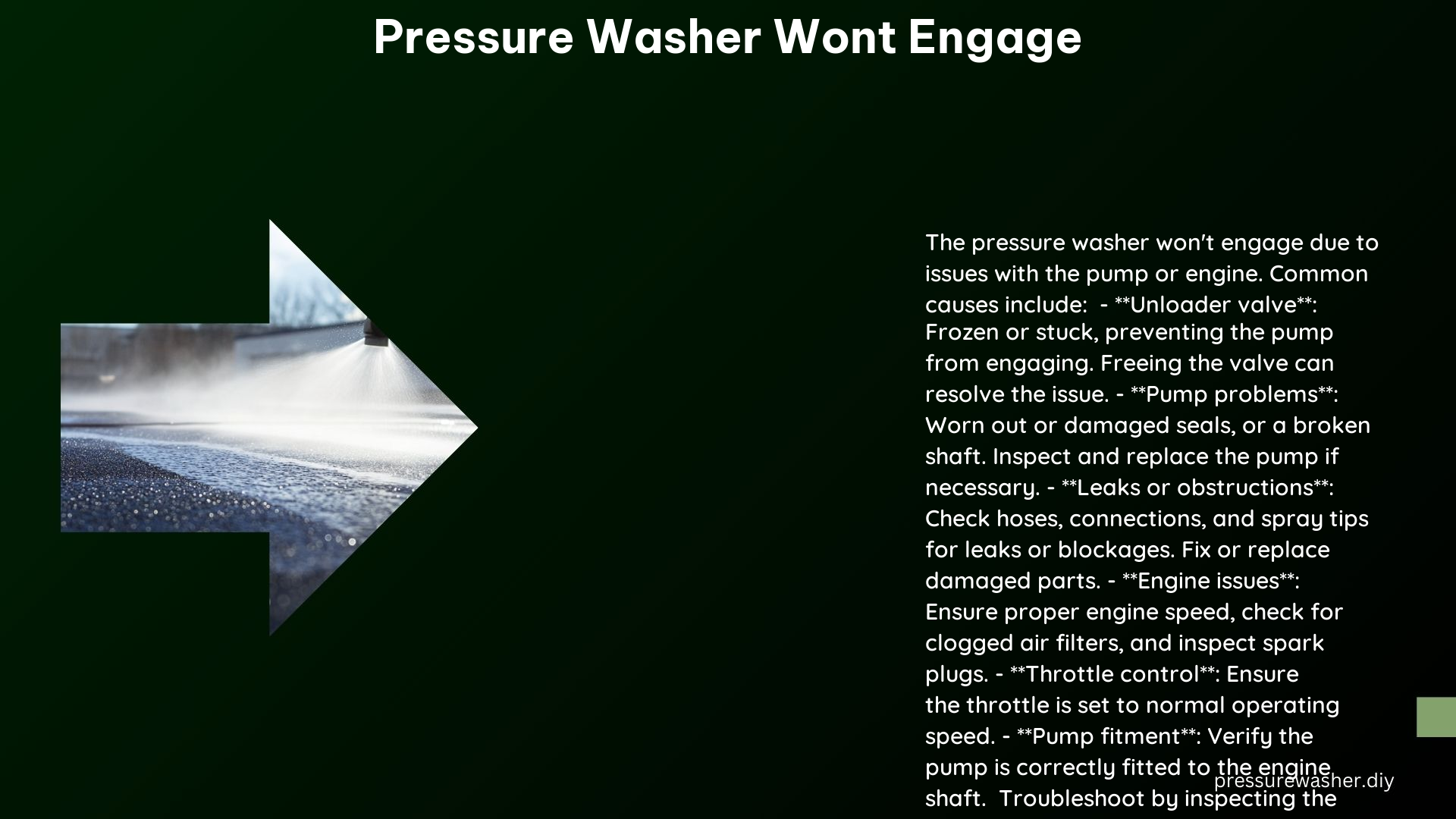If your pressure washer won’t engage, it can be a frustrating experience, but with the right troubleshooting steps and technical knowledge, you can often resolve the issue quickly. This comprehensive guide will provide you with advanced details and technical specifications to help you diagnose and fix the problem.
Common Causes of Low Pressure or No Engagement
- Clogged Nozzle or Inlet Filter:
-
Check the nozzle and inlet filter for any debris or blockages. A clogged nozzle can restrict water flow, leading to low pressure or no engagement. Clean the nozzle using a nozzle cleaning tool or replace it if necessary. Similarly, a clogged inlet filter can prevent adequate water supply, causing the same issue. Inspect and clean or replace the inlet filter as needed.
-
Worn-Out Nozzle or O-Rings:
-
Inspect the nozzle and o-rings for signs of wear and tear. Over time, these components can become damaged or worn, leading to leaks and pressure loss. Replace the nozzle and any worn o-rings to ensure a proper seal and optimal pressure.
-
Clogged Water Inlet:
-
Ensure the water inlet on your pressure washer is clear of debris and mineral buildup. A clogged inlet can restrict water flow, preventing the pump from engaging properly. Clean the inlet filter or replace it if necessary to ensure a consistent water supply.
-
Low Pressure Setting:
-
Check the pressure setting on your pressure washer and adjust it according to the manufacturer’s guidelines. If the pressure is set too low, the pump may not engage or produce the desired output.
-
Belt Slippage:
-
Inspect the drive belt for signs of wear or looseness. If the belt is slipping, it can prevent the pump from engaging properly. Tighten the belt or replace it if necessary to ensure proper power transmission.
-
Pump Issues:
-
Examine the pump for proper function. If the pump is not turning, the shaft may be broken. If the pump is turning but not producing pressure, the unloader valve may be faulty or the pump seals may be worn out. Consult the manufacturer’s instructions for pump maintenance or replacement.
-
Engine Issues:
- Ensure the engine is running correctly. Check for issues such as old or contaminated fuel, clogged air filters, fouled spark plugs, and proper engine oil levels. These problems can prevent the engine from providing the necessary power to the pump, leading to no engagement.
Troubleshooting Steps
- Verify Pump Fitment:
-
If you need to replace the pump, ensure the replacement is compatible with your pressure washer. Check the shaft diameter and orientation to ensure a proper fit.
-
Check the Pump’s Keyway:
-
Verify that the key is properly engaged with the engine shaft. If the key is missing or not aligned correctly, the pump may not engage properly. Reinstall the pump with the key in place.
-
Inspect for Leaks:
-
Carefully check the wand, pressure hose, and all connections for any leaks or damaged o-rings. Leaks can cause pressure loss and prevent the pump from engaging. Replace any worn or damaged components.
-
Adjust Unloader Valve:
-
If the pump is producing pressure but the unloader valve is not functioning correctly, adjust or replace the unloader valve according to the manufacturer’s instructions. A faulty unloader valve can prevent the pump from engaging.
-
Check Water Temperature:
- Ensure the water temperature is within the recommended range for your pressure washer. Excessively hot or cold water can affect the pump’s performance and prevent engagement.
Technical Specifications
Pressure Washer Types:
– Electric pressure washers: Typically have lower PSI ratings (1000-2000 PSI) and are suitable for lighter tasks, such as cleaning cars, patio furniture, and small outdoor areas.
– Gasoline pressure washers: Have higher PSI ratings (2000-4000 PSI) and are suitable for heavier tasks, such as cleaning driveways, siding, and heavy-duty equipment.
Pump Types:
– Axial pumps: Common in electric pressure washers, these pumps are compact and efficient, but may not be as durable as triplex pumps.
– Triplex pumps: Common in gasoline pressure washers, these pumps are more powerful and durable, making them suitable for heavy-duty applications.
PSI Ratings:
– Light-duty tasks: 1000-1500 PSI
– Medium-duty tasks: 1500-2500 PSI
– Heavy-duty tasks: 2500-4000 PSI
Reference Links
- Pressure Washer Troubleshooting and Repair
- Pressure Washer Won’t Engage
- Power Washer Will Not Engage
By following the troubleshooting steps and understanding the technical specifications of your pressure washer, you can effectively diagnose and resolve the issue of a pressure washer that won’t engage. Remember to always consult the manufacturer’s instructions and safety guidelines when working on your pressure washer.

